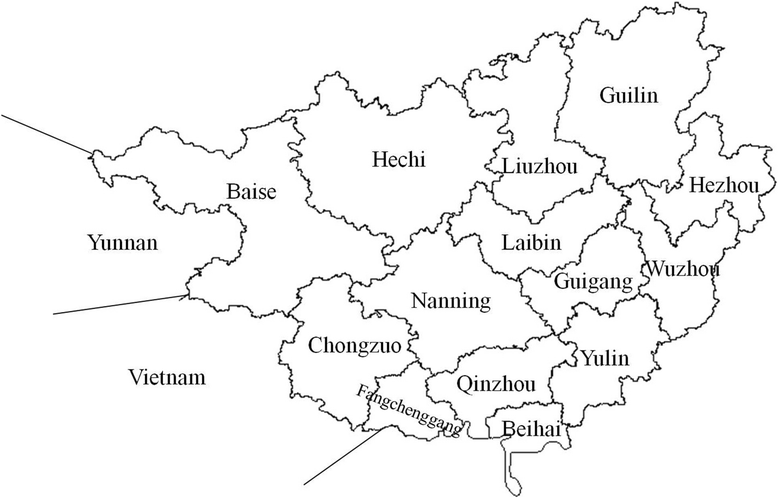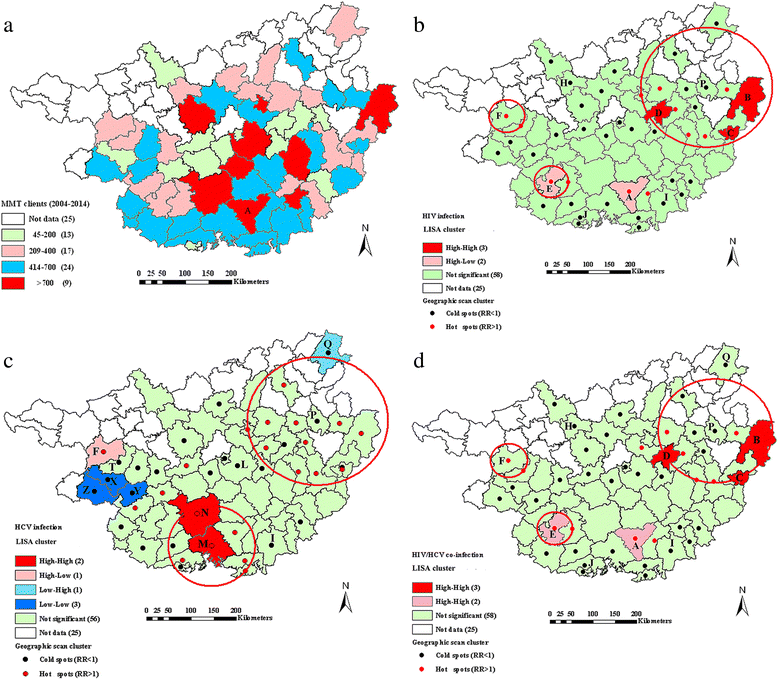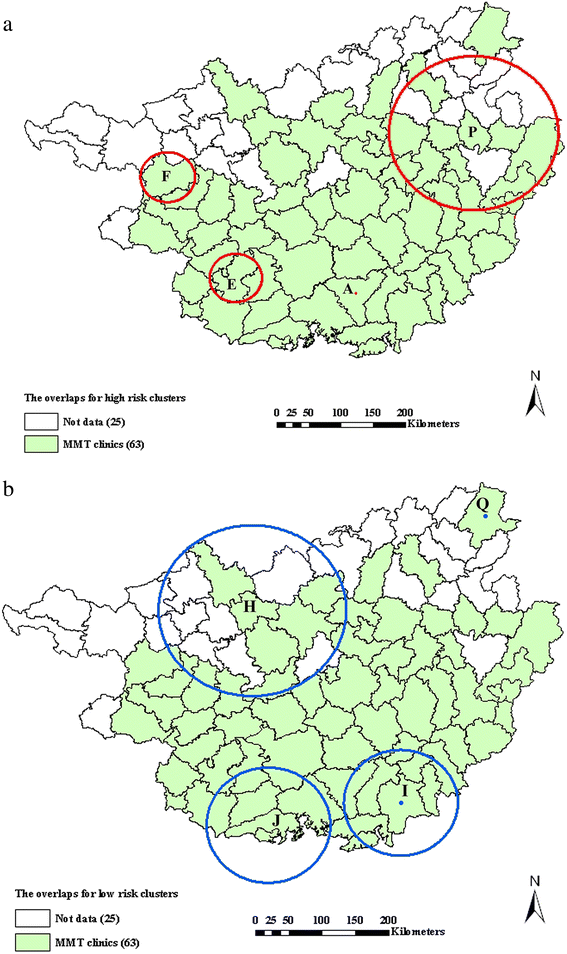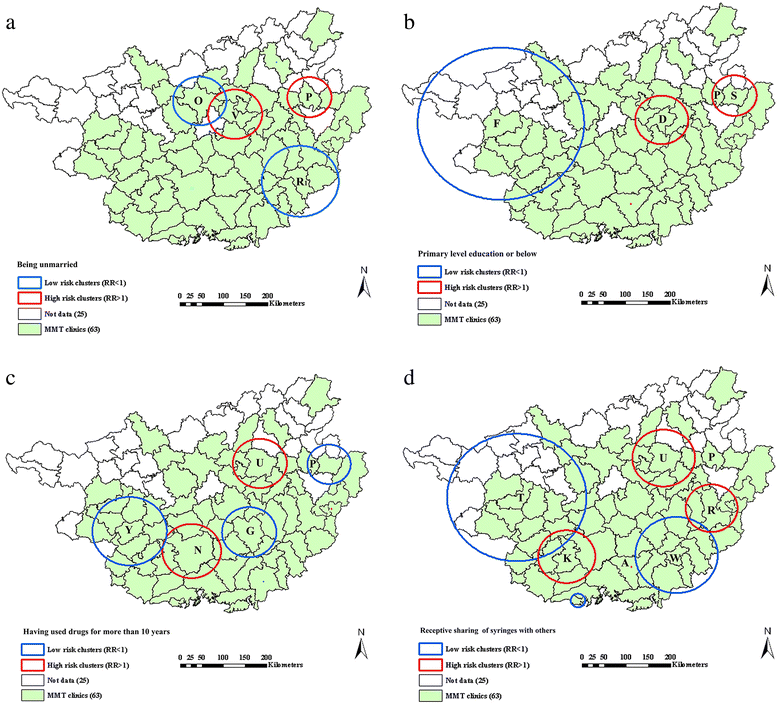Spatial distribution of HIV, HCV, and co-infections among drug users in the southwestern border areas of China (2004-2014): a cohort study of a national methadone maintenance treatment program
- PMID: 28962612
- PMCID: PMC5622551
- DOI: 10.1186/s12889-017-4769-7
Spatial distribution of HIV, HCV, and co-infections among drug users in the southwestern border areas of China (2004-2014): a cohort study of a national methadone maintenance treatment program
Abstract
Background: A methadone maintenance treatment (MMT) program to curb the dual epidemics of HIV/AIDS and drug use has been administered by China since 2004. Little is known regarding the geographic heterogeneity of HIV and hepatitis C virus (HCV) infections among MMT clients in the resource-constrained context of Chinese provinces, such as Guangxi. This study aimed to characterize the geographic distribution patterns and co-clustered epidemic factors of HIV, HCV and co-infections at the county level among drug users receiving MMT in Guangxi Zhuang Autonomous Region, located in the southwestern border area of China.
Methods: Baseline data on drug users' demographic, behavioral and biological characteristics in the MMT clinics of Guangxi Zhuang Autonomous Region during the period of March 2004 to December 2014 were obtained from national HIV databases. Residential addresses were entered into a geographical information system (GIS) program and analyzed for spatial clustering of HIV, HCV and co-infections among MMT clients at the county level using geographic autocorrelation analysis and geographic scan statistics.
Results: A total of 31,015 MMT clients were analyzed, and the prevalence of HIV, HCV and co-infections were 13.05%, 72.51% and 11.96% respectively. Both the geographic autocorrelation analysis and geographic scan statistics showed that HIV, HCV and co-infections in Guangxi Zhuang Autonomous Region exhibited significant geographic clustering at the county level, and the Moran's I values were 0.33, 0.41 and 0.30, respectively (P < 0.05). The most significant high-risk overlapping clusters for these infections were restricted to within a 10.95 km2 radius of each of the 13 locations where P county was the cluster center. These infections also co-clustered with certain characteristics, such as being unmarried, having a primary level of education or below, having used drugs for more than 10 years, and receptive sharing of syringes with others. The high-risk clusters for these characteristics were more likely to reside in the areas surrounding P county.
Conclusions: HIV, HCV and co-infections among MMT clients in Guangxi Zhuang Autonomous Region all presented substantial geographic heterogeneity at the county level with a number of overlapping significant clusters. The areas surrounding P county were effective in enrolling high-risk clients in their MMT programs which, in turn, might enable people who inject drugs to inject less, share fewer syringes, and receive referrals for HIV or HCV treatment in a timely manner.
Keywords: Co-infections; Drug users; HCV; HIV; Methadone maintenance treatment; Spatial distribution.
Conflict of interest statement
Ethics approval and consent to participate
Written informed consent was obtained from all clients. Ethical approval for the MMT was granted by the institutional review board of the National Center for AIDS/STD Control and Prevention, China CDC.
Consent for publication
Not applicable.
Competing interests
The authors declare that they have no competing interests.
Publisher’s Note
Springer Nature remains neutral with regard to jurisdictional claims in published maps and institutional affiliations.
Figures




Similar articles
-
The geographic distribution patterns of HIV-, HCV- and co-infections among drug users in a national methadone maintenance treatment program in Southwest China.BMC Infect Dis. 2014 Mar 10;14:134. doi: 10.1186/1471-2334-14-134. BMC Infect Dis. 2014. PMID: 24612875 Free PMC article.
-
[Prevalence of HIV and HCV infections in patients receiving methadone maintenance treatment in Kaiyuan, Yunnan].Zhonghua Liu Xing Bing Xue Za Zhi. 2015 Aug;36(8):829-31. Zhonghua Liu Xing Bing Xue Za Zhi. 2015. PMID: 26714537 Chinese.
-
[Related factors and interaction on HIV/HCV co-infection of patients access to methadone maintenance treatment].Zhonghua Liu Xing Bing Xue Za Zhi. 2018 May 10;39(5):631-635. doi: 10.3760/cma.j.issn.0254-6450.2018.05.017. Zhonghua Liu Xing Bing Xue Za Zhi. 2018. PMID: 29860807 Chinese.
-
HIV and HCV prevalence among entrants to methadone maintenance treatment clinics in China: a systematic review and meta-analysis.BMC Infect Dis. 2012 Jun 8;12:130. doi: 10.1186/1471-2334-12-130. BMC Infect Dis. 2012. PMID: 22682091 Free PMC article.
-
Drug Abuse, HIV, and HCV in Asian Countries.J Neuroimmune Pharmacol. 2016 Sep;11(3):383-93. doi: 10.1007/s11481-016-9665-x. Epub 2016 Mar 21. J Neuroimmune Pharmacol. 2016. PMID: 27000123 Review.
Cited by
-
HIV, syphilis and behavioral risk factors among men who have sex with men in a drug-using area of southwestern China: Results of 3 cross-sectional surveys from 2013 to 2015.Medicine (Baltimore). 2018 Apr;97(16):e0404. doi: 10.1097/MD.0000000000010404. Medicine (Baltimore). 2018. PMID: 29668597 Free PMC article.
-
Insights into the spatial epidemiology of hepatitis C infection: systematic synthesis of area-level determinants and spatiotemporal analyses.BMC Public Health. 2025 Feb 19;25(1):687. doi: 10.1186/s12889-025-21668-w. BMC Public Health. 2025. PMID: 39972312 Free PMC article.
-
Implementation of HIV non-occupational post-exposure prophylaxis for men who have sex with men in 2 cities of Southwestern China.Medicine (Baltimore). 2021 Oct 29;100(43):e27563. doi: 10.1097/MD.0000000000027563. Medicine (Baltimore). 2021. PMID: 34713829 Free PMC article.
References
-
- UNAIDS. How AIDS changes everything-MDG 6: 15 lessons of hope from the AIDS response. Geneva: the Joint United Nations Programme on HIV and AIDS; 2015.
-
- UNAIDS . A joint assessment of HIV/AIDS prevention, treatment and care in China (2004) China Ministry of Health: Beijing; 2004.
-
- UNAIDS . China’s Titanic Peril: 2001 Update of the AIDS Situation and Needs Assessment Report. China Ministry of Health: Beijing; 2002.
MeSH terms
Substances
LinkOut - more resources
Full Text Sources
Other Literature Sources
Medical

